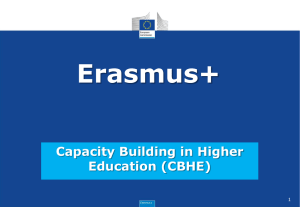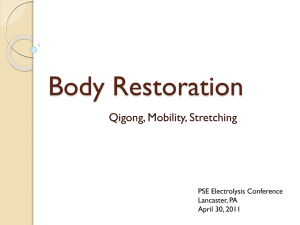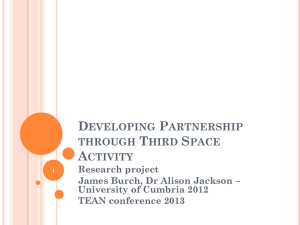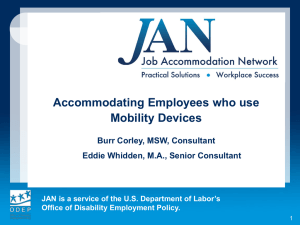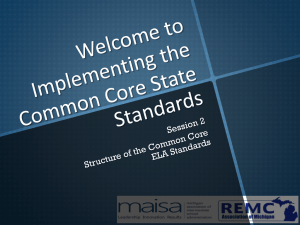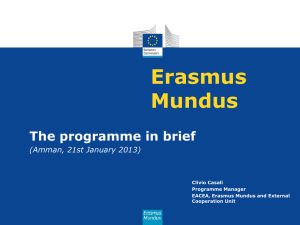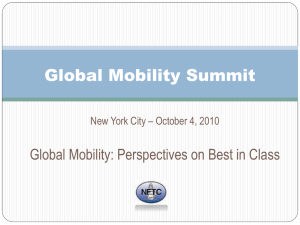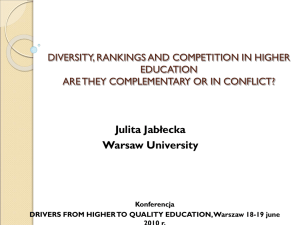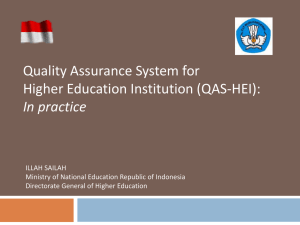CBHE Revision
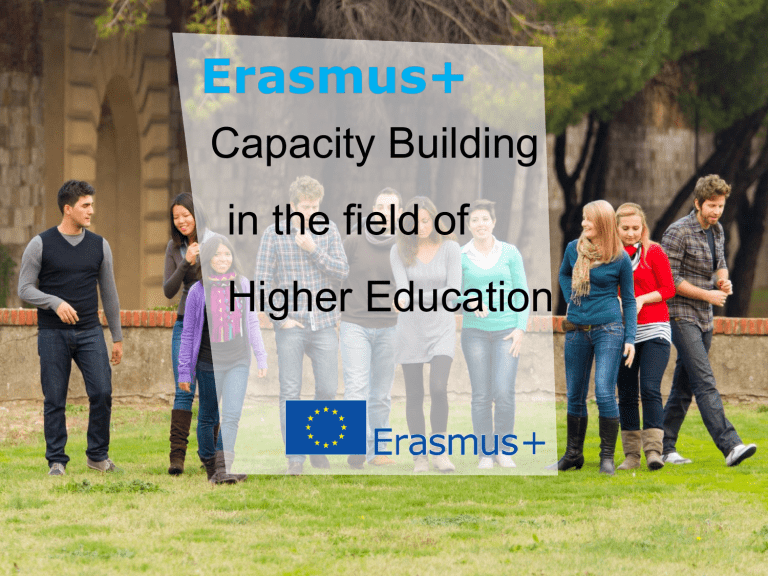
Capacity Building in the field of
Higher Education
Education and Culture
Date: in 12 pts
Part I: How? – Types of Projects
Joint Projects: => Impact
Institutions curriculum development university governance
& management
Links between HE institutions and the wider economic and social environment
Structural
Projects
:
=> Impact
Systems modernisation of policies, governance and management of higher education systems
Links between HE systems and the wider economic and social environment
2
Special
Mobility
Strand
Part I: How ?
Western Balkans, South-Mediterranean and Eastern Partnership countries ONLY
Complementary for Joint and Structural projects
Additional to the core budget
For whom? Students registered in HEIs involved in project consortia
Staff employed in a HEI or enterprise in project consortia
Programme Country to Programme Country flows are ineligible
3
Part I: How? -
Special
Mobility
Strand
Conditions:
• Mobility should be instrumental and integrated in projects objectives (no mobility on its own)
• Added value and/or innovative character of the activities proposed
(approx. 40% of the selected projects will receive additional funding)
• Comply with provisions of Erasmus Charter for Higher Education
Compulsory:
Inter-institutional agreements between institutions
Learning / mobility agreements for students and staff
Exemption of fees
4
Part I: How?
Special
Mobility
Strand
Students
Activities: Study periods (3-12 months)/traineeships-work placement. (2-12 months)
Charactericistics: - covers all cycles (BA, MA, PhD); corresponds to study area/academic discipline addressed by the project
- Students from HEIs of the consortia can study at partner HEI or do a traineeship at a consortia country institution
5
Part I: How?
Activities:
Special
Mobility
Strand
Staff
teaching & training periods (5 days to 2 months)
Charactericistics:
teaching period=> HEI teaching staff /staff from enterprises to teach at a partner HEI abroad
training period=> HEI teaching and non-teaching staff can attend at a partner HEI or any other relevant organisation in a consortia country : a) structured courses/training events
(conferences excluded); b) job shadowing/observation periods/trainings
6
Part II – The Consortia and the financing rules
7
BHE
Consortia
Priorities
Budget and
Duration
How to calculate the budget
Partnership
Agreement
8
Part II: Consortia Structure
Main
Principles
P ROGRAMME C OUNTRIES
Min. 3 countries min. 1 HEI each
P ARTNER C OUNTRIES
Partnership
Agreement s
Min. 1 country min. 2 HEIs /each
S TRUCTURAL
P ROJECTS :
Partner
Country
Ministries for HE must participate
At least as many
Partner Country HEIs as
Programme Country HEIs
9
Part II: Priorities & Project Types
National Projects Multi-Country Projects
Defined by the Ministries
of Education in close consultation with the EU
Delegations
Must address
National priorities set for
Partner Country in Regions 1,
2, 3, 7, 10
Regional priorities for the regions where no national priorities are established:
Regions 6, 7, 8, 9
Defined by the Commission and based on EU's external policy priorities
Must address the regional priorities for countries in the same region
(regional projects) or regional / national priority common to different regions
(cross-regional projects)
10
Part II: Priorities – Categories/Themes
Themes Curriculum
Development
Governance and
Management
Higher
Education and
Society
Categories
A. Subject Areas
B. Improving quality of education and training
C. Improving Management and operation of HEIs
D. Developing the HE sector within society at large
X
X X
X
X
X
X
X
11
Part II: Budget and Duration-Overview
Duration 24 or 36
Months
Min.
500,000
Euros -
Max.
1,000,000
Euros
Excluding mobility strand
Real Costs and Unit
Costs
5 Budget
Headings
12
Part II: How to calculate the budget -Categories
Staff costs
(max 40%)
Travel costs
Costs of stay
Equipment
(max 30%)
Sub-contracting
(max
10%)
4 Staff Categories (Manager,
Researcher/ Teacher/Trainer, Technician,
Administrator)
Students/staff from partners in countries involved in the project from their place of origin to the venue of the activity and return. Activities and related travels must be carried out at project beneficiaries organisation.
Subsistence, accommodation, local and public transport, personal or optional health insurance.
Purchased exclusively for the benefit of
HEIs in the Partner Countries
Exceptional for services related to
13 competences that can't be found in the consortia
Part II: How to calculate the budget -Methods
5 Budget
Categories
2 Allocation
/
Justification
Methods
Staff UC
Travel – UC
Real Costs
(RC)
Unit Costs
(UC)
Cost of Stay – UC
Equipment – RC
Sub-contracting – RC
Other types of costs
(ex.: dissemination, publishing, overheads costs, etc.) are not considered for the calculation of the grant.
>>> Expected to be covered by co-funding.
14
Part II: How to calculate the budget - STAFF COSTS
Financing mechanism for staff costs (see
Programme Guide page 158, 160 and page 161 Table A and B)
Amount
Unit costs per manager involved per day
Subdivided in 4 categories and country groups
(4 groups for Programme and 4 groups for Partner
Countries) per researcher/ teacher/trainer involved per day per technician involved per day per administrative staff involved per day
Max. 40% of the total grant
15
Part II: How to calculate the budget Travel/Cost of Stay
Costs of Stay
(see Programme Guide page 159)
Travel Costs
(see Programme Guide page 158) for eligible activities please refer to page 287-288
DAYS
1-14
15-60
61 - 180
STAFF STUDENTS
120€
70€
50€
55€
40€ n.a.
Distance Bands Unit Cost
100-499 km 180€
500-1999 km
2000-2999 km
275€
360€
3000-3999 km
4000-7999 km
8000 km and more
530€
820€
1.100€
16
Part II: How to calculate the budget - Travel/Cost of Stay http://ec.europa.eu/programmes/erasmusplus/tools/distance_en.htm
Example 1:
Staff Trip: From Paris to Bxl
( 308 KM )
Duration 2 days
Real expense:
Travel Costs :120 €
Hotel + Subsistence Costs (250 €)
Total real expenses: 370 €
Example 2 :
Staff Trip: From Paris to Berlin
( 771 KM )
Duration 2 days
Real expense:
Travel Costs :250 €
Hotel + Subsistence Costs (300 €)
Total real expenses: 550 €
Calculation (unit-costs):
Travel Costs: 180 €
Costs of Stay: 2 x 120 € =240 €
Total unit-costs: 420 €
Calculation (unit-costs):
Travel Costs: 275 €
Costs of Stay: 2 x 120 € =240 €
Total unit-costs: 515 €
17
Part II: How to calculate the budget
Special
Mobility
Strand
Max. 80% of the total EU grant awarded for the joint or structural project (excluding the mobility strand)
(see Programme Guide page 162-165)
Travel costs
Cost of Stay
18
Part II: How to calculate the budget -
Travel Costs
Distance Bands Unit Cost
100-499 km
500-1999 km
2000-2999 km
3000-3999 km
4000-7999 km
8000 km and more
180€
275€
360€
530€
820€
1.100€
Special
Mobility
Strand
19
Part II: How to calculate the budget
STUDENTS - Cost of Stay
650 €
Costs of Stay €/Month
Students from
Programme
Countries
Irrespective of hosting country
Students from
Partner countries
Country group 1
Country group 2 hosting
850 € hosting
800 €
Special
Mobility
Strand
Country group 3 + 4 hosting
750 €
20
Special
Mobility
Strand
Part II: How to calculate the budget
STAFF Costs of Stay
Cost of Stay €/Day
Staff from Partner Countries
Cost of Stay €/Day
Staff from Programme Countries
Days
Country group 1 hosting
Country group 2 hosting
Country group 3 hosting
Country group 4 hosting
Days
Irrespective of hosting country
1-14 160 € 140 € 120 € 100 € 1-14 160 €
15-60 112 € 98 € 84 € 70 € 15-60 112 €
21
Part III – The application and
Selection procedure
22
How and what do I submit?
What is assessedcriteria?
BHE
Continuity and
Changes
By whom -
Selection
Process?
23
Part III- Application and Selection procedure
Indicative roadmap for selection process
Steps Date
Publication of the Call for Proposals Oct. 2014
Deadline for submission of applications
10 February 2015
Expert assessment
Consultation of local/regional stakeholders
March-April 2015
May-June 2015
Award Decision
Notification of applicants and
Publication of results on EACEA web site
Preparation and signature of grant agreements
Start of Eligibility Period
July 2015
July-August 2015
August –September 2015
15 October 2015
24
Part III: How and what do I submit? - General
When? How? Where?
One deadline - One-phase submission - on-line to EACEA
Application form = unique reference information for the submission deadline.
What?
Specific application form: eForm : project data – parts A, B, C
+ compulsory annexes:
Pre-filled with info from Participant
Portal - PIC
Detailed project description (Word doc) – parts D, E, F, G, H, I, J
Budget tables (Excel doc)
Declaration of Honour+ Mandates (in one single PDF doc)
25
Part III: How and what do I submit ?
Application form - structure & contents
eForm (PDF Adobe doc)
A.
B.
C.
Identification of the applicant and other partners
Description of the project (summary information)
Specific information related to CBHE
Detailed project description (Word doc. Attached to eForm)
D.
Quality of the project team and the cooperation arrangements
E.
Project characteristics and relevance
F.
G.
H.
I.
J.
Quality of the project design and implementation
Impact, dissemination and exploitation, sustainability;
LFM; Workplan
Work packages
Special Mobility Strand (where applicable)
Other EU Grants
26
Part III: What is assessed?
Assessment of CBHE Projects
Eligibility
Criteria
Exclusion
&
Selection
Criteria
Award
Criteria
27
Part III: What is assessed? Eligibility Criteria
Formal submission requirements
Grant size and duration
Applicant, Partners and Partnership requirements (number of partners, status of the grant applicant & partners, etc.)
28
Part III: What is assessed? Exclusion and Selection
Criteria
The institution is not in one of the situations described in
section C. Exclusion criteria of the Guidelines (such as bankruptcy, professional misconduct, subject of fraud, corruption, administrative penalties, conflict of interest, etc.)
Legal person status of the applicant organisation
Financial capacity to complete the proposed activities (private entities only)
Operational capacity to complete the proposed activities
Based on supporting and administrative documents, like the declaration of honour, legal entity form, profit and loss accounts...
29
Part III: What is assessed? Award Criteria
Relevance
(30 points)
Quality of
Design +
Implementation
(30 points)
Quality of
Team +
Cooperation arrangements
(20 points)
Impact and
Sustainability
(20 points)
To be considered for funding, proposals must score at least 60 points in total and - out of these points at least 15 points for
"Relevance"
30
Part III: What is assessed?
Award Criterion 1 – Relevance
DEFINITION
• The project contributes to the achievement of the policy objectives of the participating partners
• It is based on and addresses real needs
& problems of the target groups
CONTENT
• How clearly the project addresses the Programme
objectives and priorities
(annual, thematic, geographical priorities)
• Needs analysis and presentation of specific
problems addressed
• Definition of target groups
• What is innovative or complementary to other initiatives
• How the project was prepared
Part III: What is assessed ?
Award Criterion 2 -
Quality of Design and Implementation
DEFINITION
• The activities proposed are appropriate to achieve the specific and wider objectives
• It uses the most appropriate methodology
• It demonstrates a logical and sound planning capacity
CONTENT
Description of the project as a whole, including:
• specific objectives
• activities, expected
outcomes, wider and specific objectives
• academic content and pedagogical approach
• involvement of academics, students and stakeholders at large
• quality control processes
32
Part III: What is assessed?
Award Criterion 3 - Quality Team and Cooperation
DEFINITION
• The partnership includes all the skills, recognised expertise and competences required
• Suitable distribution of tasks
• Sound communication and coordination
CONTENT
• Presentation of the partners
competences and roles in the project
• Description of any
complementary skills, expertise and competences directly relating to the planned project activities
• ensure regional dimension
• Planned measures to ensure effective communication
33
Part III: What is assessed?
Award Criterion 4 - Impact and Sustainability
DEFINITION
• Information/outcomes of the project are made available to groups not directly involved
(multiplier effect)
• Optimal use of the results during & beyond the project lifetime
• Expected impact will be substantial and sustainable in the long term (financial, institutional and policy level)
CONTENT
• Expected impact at different levels
• Dissemination strategy: outputs to be disseminated, target groups, dissemination tools & activities
• Measures planned to ensure the sustainability of project outcomes and outputs at
three levels: financial, institutional and political
• Evidence of impact on HE at institutional / national level in
PCs
34
Special
Mobility
Strand
DEFINITION
• Full contribution to the achievement of the related project and added value of the project
• Transparent procedures selection of participants
• Quality systems
Part III: What is assessed?
Quality
Design & Implementation
Additional
Award
Criteria
CONTENT
Relevance of the mobility strand for the project
Well-articulated with the project; demonstrated added value
Demonstration of positive
impact for individual and institutions
Validation and
recognition at institutional level
35
Part III: What is assessed? - Selection Process
Project
Proposal
EACEA
Assessment by
Independent experts
EACEA
Evaluation
Committee
EACEA, DGs,
EEAS
EACEA
Eligibility check
Ranking on
QUALITY based on award criteria
Consultation: EU
Delegations, PC authorities, NEOs
Final ranking list
Grant Award
Decision
Part III: What is assessed? - Award Decision
EACEA takes decision based on:
Evaluation
Committee's recommendation taking into account : ranking list on quality established by external experts the results from the consultation process the budget available for each region the need to achieve a geographical balance within a region sufficient coverage of the priorities
37
38
